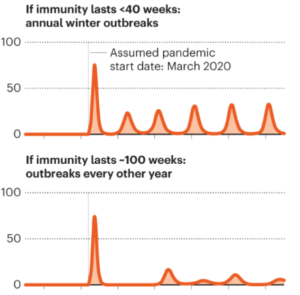This is the foremost question in the minds of most of our clients. Many of us suffer tremendously from secondary impacts of the COVID-19 pandemic: jobs lost, careers disrupted, no schooling for children, lack of normal social interactions, cancelled holidays, and more. Everyone wants to know – when it will end?
Scientifically speaking, the pandemic ends in only one of two situations:
- Elimination – when new cases decline to minimal level (or zero)
- Eradication – when the virus is completely and permanently wiped-out
Given how widespread COVID-19 is, it’s unlikely that we can achieve eradication. There will probably always be pockets of virus surviving in different parts of the world to sustain its continued existence for years. We should perhaps instead count on local elimination, e.g. within the US. This can be achieved if and when 55-80% of population become immune to the virus through either prior infection or vaccination.
In fighting COVID-19, we are looking at newly developed or still-to-be-developed tools for our arsenal, such as:
- The new generation of rapid, cheaper tests, such as the $5-per-test kit designed by Abbot, which takes only 15 minutes to perform and has ~97-98% accuracy.
- Recognition of COVID through voice samples. To date, several teams have achieved 80-90% detection accuracy based on listening to coughs or from monitoring brief normal voice samples (e.g. Sonde Health, Soniphi, AI4COVID).
- Drugs and treatment options – antiviral drugs such as remdesivir, anti-inflammatory drugs such as corticosteroid dexamethasone, alternative approach to ventilation of patients, etc.
- Vaccine – the option most governments are betting on. Over 150 vaccines are now in development around the world, with Russia already in deployment phase with its Sputnik-5. A viable vaccine has the biggest potential for stifling the pandemic, if applied at scale.
How effective will those new measures be? When will they make difference?
The application of drugs and newer treatment protocols can be scaled up in Q4 2020. Vaccines at scale will probably not be available until “well into 2021” as per CDC guidance dated September 16th, 2020.
Will the vaccine eliminate COVID-19?
This boils down to the effectiveness of vaccine coverage (i.e. what percentage of the population will be vaccinated) and the effectiveness of the vaccine itself. While we can influence what percentage get vaccinated (by making it mandatory), we do not have control over the second, far more important parameter – how much immunity will the vaccine provide and for how long?
Almost everything boils down to that question. If immunity provided by vaccine is permanent or lasts for decades (as with measles and polio vaccines), then the virus could burn itself out and disappear by the end of 2021.
However, if immunity lasts only 40 weeks, as in the case with two other human coronaviruses, OC43 and HKU1, we can expect annual outbreaks. Also, if the virus mutates, it might make the currently developed vaccines ineffective. The graph below illustrates hypothetical future COVID-19 prevalence per 1,000 people for scenarios with 40- and 100-week immunity.

Source: Nature
The bottom line is that the second half of 2021 should give (at least in the US) renewed hope in fighting the virus and measurable results, plus a real chance of containing or (locally) eliminating the epidemic by 2022.
Whether this will be a permanent victory will mostly depend on the duration of vaccine immunity. If it is relatively short, we may have to get used to living with coronavirus for many years to come.
Sources:
National Geographic
https://www.ncbi.nlm.nih.gov/pmc/articles/PMC7443854/
www.sondehealth.com
https://www.sciencedirect.com/science/article/pii/S2352914820303026
www.cdc.gov




